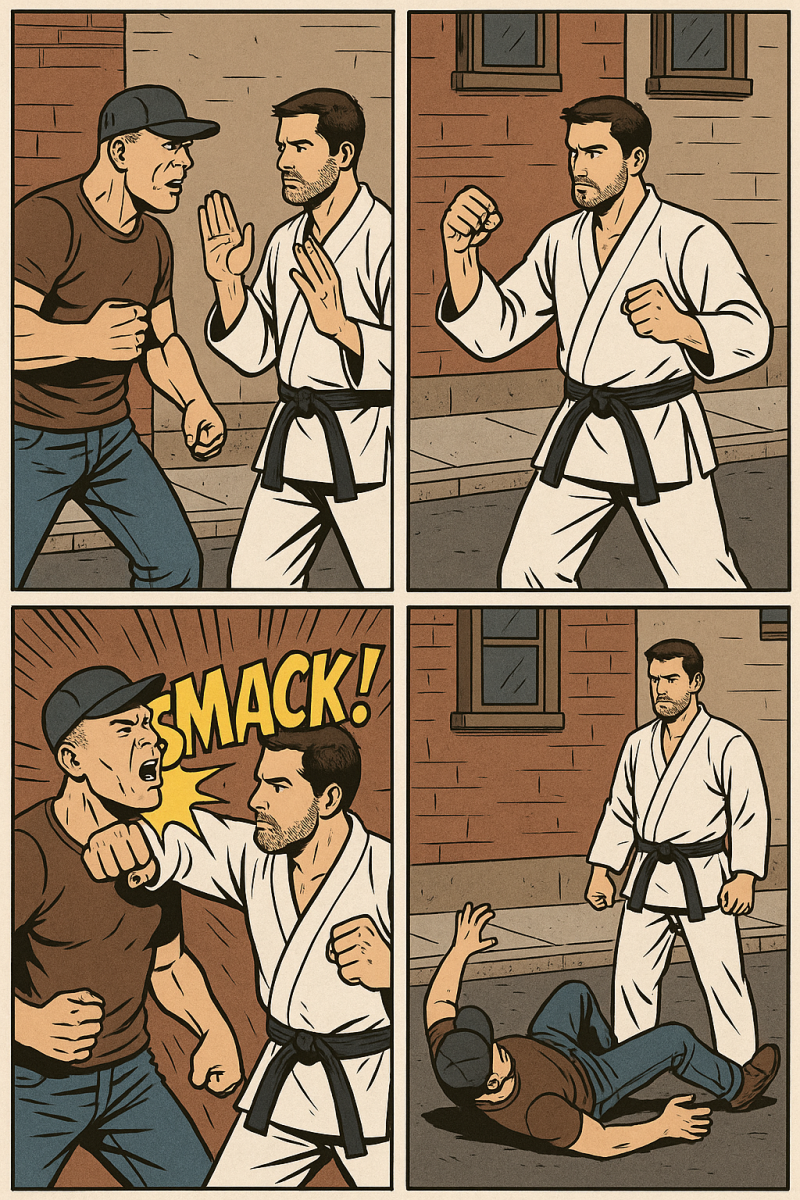Let me share some thoughts about a topic that constantly pops up online: which martial art is the best for self-defense?
To begin with, I still consider myself an eternal white belt, even though I have about 15 years of training spread across more than 45 years in different styles. So I think I’m allowed to have an opinion on the subject.
First of all, a person’s ability to defend themselves on the street doesn’t depend on which martial art they train, but how they train it.
It also depends heavily on the individual—whether they have a fighter’s heart.
On top of that, many other factors matter: the situation itself, your physical condition at that moment, situational awareness, and so on.
But let’s get back to the martial art itself. I entered the world of martial arts in 1982, when I started Taekwon-Do at the age of 13. I believe that the Taekwon-Do of that time has very little to do with what is taught today in most TKD clubs and schools. Today, everything seems focused on sport and earning medals. The same is true for many Karate, Judo, and Jiu-Jitsu schools.
My instructor back then didn’t care about competitions at all. He was a military and police instructor specializing in anti-terror combat. His own teacher was a Korean Vietnam War veteran and former close-combat instructor for American soldiers.
What we trained was a martial art, not an Olympic sport.
At the same time, I briefly trained boxing, and later, after an injury and a more extended break, I continued with Budokai Karate.
By the age of 17–18, I had stopped training entirely (reaching 8th Kup in TKD and an orange belt in Budokai Karate). All those training sessions—TKD, boxing, Karate—were physically demanding. Besides techniques, we trained the body. Even though I was skinny, I was tough.
Some 25–26 years later, I returned to martial arts, starting with Wing Chun. After about three years, I realized it wasn’t leading anywhere. Not because Wing Chun is a bad system—it isn’t—but because the people training it weren’t training for real-life self-defense. They were essentially recreating scenes from the Ip Man movies.
Training intensity was so low that I would come home and do my real workout afterward (pull-ups, push-ups, squats, etc.).
Some people there, even at so-called “black belt level,” I’m not sure could even do 10 push-ups—and if they could, I’m not sure they knew how to do them correctly.
Again, the issue wasn’t Wing Chun itself, but the way it was being trained. In my opinion, it’s a very effective martial concept, but the way some people train it is not.
After that, I trained Kyokushin Karate for several years, and that was a completely different story: physically brutal training that strengthens the body and mentally prepares you for real combat. You give real strikes and you take real strikes. In my view, it’s essential to learn how to handle a hit—keep your guard up, take the pain, and immediately counterattack.
Then came COVID, followed by some injuries, and I paused training again. Eventually, I joined another Karate club that trained according to modern non-contact competition standards. There was barely any traditional Karate there—hardly any Kihon, Kata, or full-contact Kumite. Everything revolved around point-style sparring. The body was trained to throw a kick, but not actually to hurt an opponent.
A little over two months ago, I started Jiu-Jitsu, and I once again felt that real physical and mental stress of real fighting—real sparring and exhausting training sessions that prepare your body for real-world situations.
And that, I think, is the key difference between martial arts schools:
Are they training you for sport and medals, or for the street as well?
If they prepare you for real-life combat, then the training must reflect that. You must learn how to strike, how to take a strike, how to deal with stress, and build strength and conditioning so you can actually endure a confrontation.
For example, if in a Jiu-Jitsu class a guy who’s 40 kg (88 lbs) heavier than me is lying on top of me, I learn—within the safety of the dojo—how to handle that situation and react correctly. But if all I ever do is jump around yelling kiai without ever hitting anyone or making real contact, then in a real fight I might be completely shocked—just like I was as a kid in school.
As the famous UFC champion GSP once said while comparing different styles:
“…at the end of the day, a punch is a punch and a kick is a kick.”
It all depends on how you were trained to deliver them.
So that’s the opinion of a layman who holds a yellow belt in Taekwon-Do, an orange belt in Budokai Karate, a white belt in Kyokushin Karate, a green belt in Shotokan Karate, and a white belt in Jiu-Jitsu.

Add comment
Comments